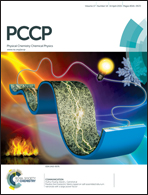Encapsulation of haloalkane 1-(3-chlorophenyl)-4-(3-chloropropyl)-piperazinium in symmetrical α,α′,δ,δ′-tetramethyl-cucurbit[6]uril†
Abstract
Complexation of haloalkane 1-(3-chlorophenyl)-4-(3-chloropropyl)-piperazinium (PZ+) dihydrochloride with symmetrical α,α′,δ,δ′-tetramethyl-cucurbit[6]uril (TMeQ[6]) has been investigated using NMR spectroscopy, MALDI-TOF mass spectrometry, isothermal titration calorimetry (ITC), and X-ray crystallography. Our data indicate that the chloropropyl group of PZ+ resides within the cavity of TMeQ[6] in both aqueous solution and the solid state, generating a highly stable inclusion complex PZ+@TMeQ[6]. In aqueous solution, the formation of the inclusion complex PZ+@TMeQ[6] benefits from the ion–dipole interactions between the guest PZ+ and the host TMeQ[6]. While in the solid state, hydrogen-bonding interactions also play an important role in stabilizing the inclusion complex PZ+@TMeQ[6].
![Graphical abstract: Encapsulation of haloalkane 1-(3-chlorophenyl)-4-(3-chloropropyl)-piperazinium in symmetrical α,α′,δ,δ′-tetramethyl-cucurbit[6]uril](/en/Image/Get?imageInfo.ImageType=GA&imageInfo.ImageIdentifier.ManuscriptID=C5CP00152H&imageInfo.ImageIdentifier.Year=2015)

 Please wait while we load your content...
Please wait while we load your content...